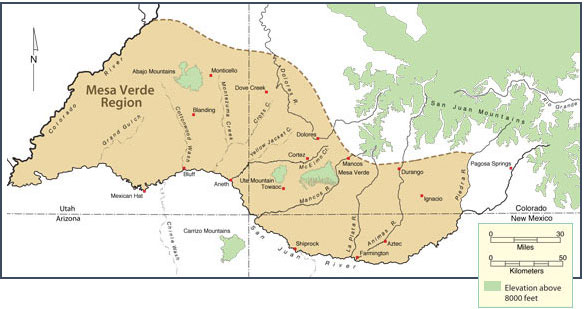Introduction
People have lived in the Mesa Verde region of the American Southwest for thousands of years. For the vast majority of that time, the inhabitants were American Indians—hunters, foragers, and farmers who thrived in the canyon-and-mesa country of what today encompasses portions of southwestern Colorado, southeastern Utah, and northwestern New Mexico. Only in the last approximately 250 years have other people—mostly Europeans and Americans of European descent—moved into the area.

The Mesa Verde archaeological region. To see where the Mesa Verde region is located within the larger Colorado Plateau, click here.
As defined here, the Mesa Verde archaeological region is an area of just under 10,000 square miles bounded by the Colorado, Piedra, and San Juan rivers. It is located within the larger physiographic region known as the Colorado Plateau, an immense area of geologic uplift encompassing much of western Colorado, eastern Utah, northern Arizona, and northwestern New Mexico.
The Mesa Verde region is a land of spectacular contrasts, where deep sandstone canyons dissect sage-covered plains, all against the distant backdrop of the San Juan Mountains, which are part of the Colorado Rocky Mountains. Cold, snowy winters give way to hot, dry summers, and periods of relatively abundant moisture are punctuated by sporadic—but sometimes prolonged—periods of drought. Living off the land has always been, and continues to be, a challenge, but one that people through the ages have met with extraordinary ingenuity and resilience.
From the arrival of Ice Age hunters to the introduction of agriculture and eventually the creation of modern cities and towns, the story of how people have adapted to, and flourished in, this rugged land is one of the most fascinating stories in human history. And it is a story that is still unfolding, as archaeologists continue to make discoveries that shed new light on the ancient past—and as the people who live in the region today continue to forge their own histories. |